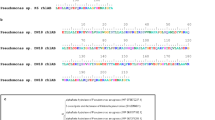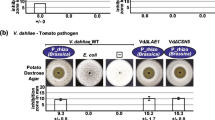Abstract
A Pseudomonas strain MRS16 inhibited growth of different pathogenic fungi (Aspergillus sp., Fusarium oxysporum, Pythium aphanidermatum and Rhizoctonia solani) in vitro. Larger inhibition zones were obtained on nutrient agar and King's B media compared to potato dextrose agar and pigment production media. Mutants altered in production of fluorescent pigment were derived by nitrosoguanidine mutagenesis. The pigment overproducer mutant MRS16M-1 was more inhibitory whereas nonproducer mutant MRS16M-5 was less inhibitory than parent strain on nutrient agar medium. Addition of iron (100 µM FeCl3) in the medium decreased inhibition of fungal growth, suggesting the involvement of siderophores and other antifungal secondary metabolites. Seed bacterization of two cultivars of chickpea (Cicer arietinum cvs. H8618 and C235) differing in susceptibility to wilt caused initial root and shoot stunting at 5 d of growth followed by proliferation of secondary root growth at 10 d. Coinoculation of chickpea with Pseudomonas strain MRS16 or mutants and Rhizobium sp. Cicer strain Ca181 enhanced nodulation, nitrogen fixation and plant dry mass as compared to single inoculation with Rhizobium strain under sterile conditions.
Similar content being viewed by others
References
Astrom, B., Gustafsson, A., Gerhardson, B.: Characteristics of a plant deleterious rhizosphere pseudomonad and its inhibitory metabolite(s).-J. appl. Bacteriol. 74: 20-28, 1993.
Bolton, H., Jr., Elliott, L.F.: Toxin production by a rhizobacterial Pseudomonas sp. that inhibits wheat root growth.-Plant Soil 114: 269-278, 1989.
Bolton, H., Jr., Elliott, L.F., Turco, R.F., Kennedy, A.C.: Rhizoplane colonization of pea seedlings by Rhizobium leguminosarum and a deleterious root colonizing Pseudomonas sp. and effects on plant growth.-Plant Soil 123: 121-124, 1990.
Chang, P.C., Blackwood, A.C.: Simultaneous production of three phenazine pigments by Pseudomonas aeruginosa Mac 436.-Can. J. Microbiol. 15: 439-444, 1969.
Dadarwal, K.R., Sindhu, S.S., Batra, R.: Echology of Hup+ Rhizobium strains of cowpea miscellany: native frequency and competence.-Arch. Microbiol. 141: 255-259, 1985.
Dashti, N., Zhang, F., Hynes, R., Smith, D.L. Application of plant growth-promoting rhizobacteria to soybean [Glycine max (L.) Merr.]increases protein and dry matter yield under short-season conditions.-Plant Soil 188: 33-41, 1997.
De Freitas, J.R., Germida, J.J.: Plant growth-promoting rhizobacteria for winter wheat.-Can. J. Microbiol. 36: 265-272, 1990.
Dubeikovsky, A.N., Mordukhova, E. A., Kochetkov, V.V., Polikarpova, F.Y., Boronin, A.M.: Growth promotion of blackcurrant softwood cuttings by recombinant strain Pseudomonas fluorescens BSP53a synthesising an increased amount of indole-3-acetic acid.-Soil Biol. Biochem. 25: 1277-1281, 1993.
Elad, Y., Baker, R.: The role of competition for iron and carbon in suppression of chlamydospore germination of Fusarium spp. by Pseudomonas spp.-Phytopathology 75: 1053-1059, 1985.
Fredrickson, J.K., Elliott, L.F., Engibous, J.C.: Crop residues as substrate for host-specific pseudomonads.-Soil Biol. Biochem. 19: 127-134, 1987.
Fridlender, M., Inbar, J., Chet, I.: Biological control of soil borne plant pathogens by a β-1,3-glucanase-producing Pseudomonas cepacia.-Soil Biol Biochem. 25: 1211-1221, 1993.
Goel, A.K., Sindhu, S.S., Dadarwal, K.R.: Application of plant growth-promoting rhizobacteria as inoculants of cereals and legumes.-In: Singh, T., Yadav, A.K., Raychaudhury, S. (ed.): Recent Advances in Biofertilizer Technology. University Publications, New Delhi 2000. (In press).
Gurusiddaiah, S., Weller, D.M., Sarkar, A., Cook, R.J.: Characterization of an antibiotic produced by a strain of Pseudomonas fluorescens inhibitory to Gaeumannomyces graminis var. tritici and Pythium spp.-Antimicrob. Agents Chemother. 29: 488-495, 1986.
Hebbar, K.P., Davey, A.G., Dart, P.J.: Rhizobacteria of maize antagonistic to Fusarium moniliforme, a soil-borne fungal pathogen: colonization of rhizosphere and roots.-Soil Biol. Biochem. 24: 989-997, 1992.
James, D.W., Gutterson, N.I.: Multiple antibiotics produced by Pseudomonas fluorescens HV37a and their differential regulation by glucose.-Appl. environ. Microbiol. 52: 1183-1189, 1986.
Kanner, D., Gerber, N.N., Bartha, R.: Pattern of phenazine pigment production by a strain of Pseudomonas aeruginosa.-J. Bacteriol. 134: 690-692, 1978.
Kloepper, J.W., Leong, J., Teintze, M., Schroth, M. N.: Enhanced plant growth by siderophores produced by plant growth-promoting rhizobacteria.-Nature 286: 883-884, 1980.
Kloepper, J.W., Scher, F.M., Lalibert, E.M., Tipping, B.: Emergence promoting rhizobacteria: description and implications for agriculture.-In: Swinburne, T.R. (ed.): Iron, Siderophores and Plant Diseases. Pp. 155-164. Plenum Press, New York 1986.
Knight, T.J., Langston-Unkefer, P.J.: Enhancement of symbiotic dinitrogen fixation by a toxin-releasing plant pathogen.-Science 241: 951-994, 1988.
Leong, J.: Siderophores: their biochemistry and possible role in the biocontrol of plant pathogens.-Annu. Rev. Phytopathol. 24: 187-209, 1986.
Lifshitz, R., Kloepper, J.W., Kozlowski, M.: Growth promotion of canola (rapeseed) seedlings by a strain of Pseudomonas putida under gnotobiotic conditions.-Can. J. Microbiol. 33: 390-395, 1987.
Loper, J.E., Buyer, J.S.: Siderophores in microbial interactions on plant surfaces.-Mol. Plant-Microbe Interact. 4: 5-13, 1991.
Loper, J.E., Schroth, M.N.: Influence of bacterial sources of indole-3-acetic acid on root elongation of sugarbeet.-Phytopathology 76: 386-389, 1986.
Mandeel, Q., Baker, R.: Mechanisms involved in biological control of Fusarium wilt of cucumber with strains of non-pathogenic Fusarium oxysporum.-Phytopathology 81: 462-469, 1991.
Marek-Kozaczuk, M., Deryto, M., Skorupska, A.: Tn5 insertion mutants of Pseudomonas sp. 267 defective in siderophore production and their effect on clover (Trifolium pratense) nodulated with Rhizobium leguminosarum bv. trifolii.-Plant Soil 179: 269-274, 1996.
Parmar, N., Dadarwal, K.R.: Stimulation of nitrogen fixation and induction of flavonoid-like compounds by rhizobacteria.-J. appl. Microbiol. 86: 36-44, 1999.
Rosales, A.M., Thomashow, L., Cook, R.J., Mew, T.W.: Isolation and identification of antifungal metabolites produced by rice-associated antagonistic Pseudomonas spp.-Phytopathology 85: 1028-1032, 1995.
Sakthivel, N., Sivamani, E., Unnamalai, N., Gnanamanickam, S.S.: Plant growth-promoting rhizobacteria in enhancing plant growth and suppressing plant pathogens.-Curr. Sci. 55: 22-25, 1986.
Sambrook, J., Fritsch, E.F., Maniatis, T.: Molecular Cloning: a Laboratory Manual.-Cold Spring Harbor Laboratory, New York 1989.
Schwyn, B., Neilands, J.B.: Universal chemical assay for the detection and determination of siderophores.-Anal. Chem. 160: 47-56, 1987.
Sindhu, S.S., Dadarwal, K.R.: Ex planta nitrogenase induction and uptake hydrogenase in Rhizobium sp. (cowpea miscellany).-Soil Biol. Biochem. 18: 291-295, 1986.
Sindhu, S.S., Gupta, S.K., Dadarwal, K.R.: Antagonistic effect of Pseudomonas spp. on pathogenic fungi and enhancement of plant growth in green gram (Vigna radiata).-Biol. Fertil. Soils 29: 62-68, 1999.
Sloger, C.: Symbiotic effectiveness and nitrogen fixation in nodulated soybean.-Plant Physiol. 44: 1666-1668, 1969.
Somasegaran, P., Hoben, H.J.: Methods in Legume-Rhizobium Technology.-Niftal University of Hawaii Publication, Hawaii 1985.
Voisard, C., Keel, C., Hass, D., Defago, G.: Cyanide production by Pseudomonas fluorescens helps suppress black root rot of tobacco under gnotobiotic conditions.-EMBO J. 8: 351-358, 1989.
Zhang, F., Dashti, N., Hynes, R.K., Smith, D.L.: Plant growth-promoting rhizobacteria and soybean [Glycine max (L.) Merr.]growth and physiology at suboptimal root zone temperature.-Ann. Bot. 79: 243-249, 1997.
Author information
Authors and Affiliations
Rights and permissions
About this article
Cite this article
Goel, A., Sindhu, S. & Dadarwal, K. Pigment Diverse Mutants of Pseudomonas sp.: Inhibition of Fungal Growth and Stimulation of Growth of Cicer arietinum. Biologia Plantarum 43, 563–569 (2000). https://doi.org/10.1023/A:1002877917537
Issue Date:
DOI: https://doi.org/10.1023/A:1002877917537




